

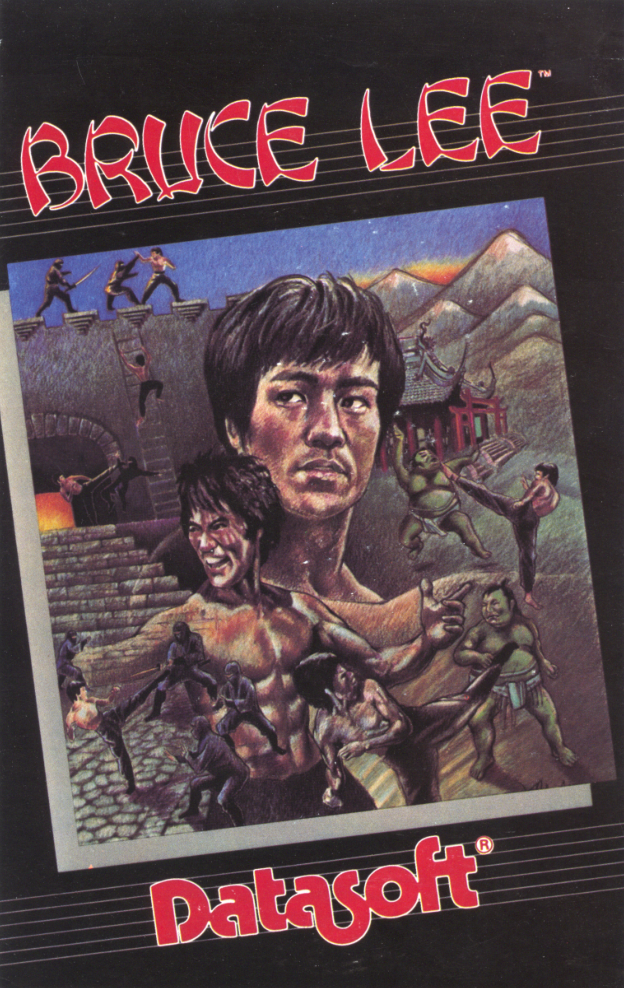
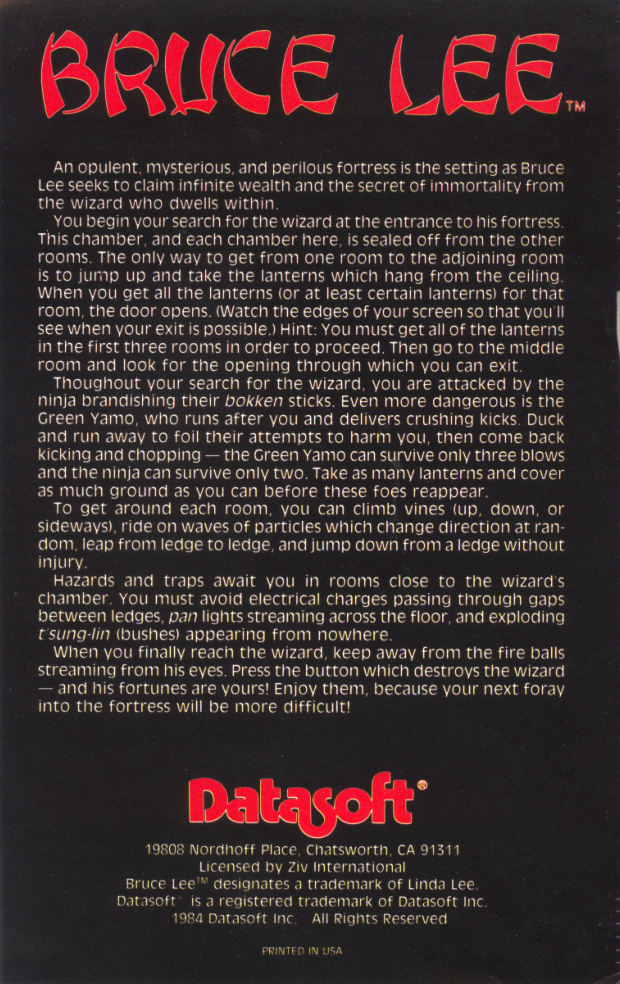
In what is considered the first ever platforming beat'em up, our eponymous hero must fight his way through the mysterious and perilous fortress in a quest to overthrow the evil Wizard, claim infinite wealth and the secret of immortality.
Ron J. Fortier, a programmer in the California based software company Datasoft, Inc. had just finished converting Sega's Zaxxon to the Atari 8-bit. While waiting for his next assignment, he continued his research on the inner workings of the Atari by tinkering with a platforming game engine.
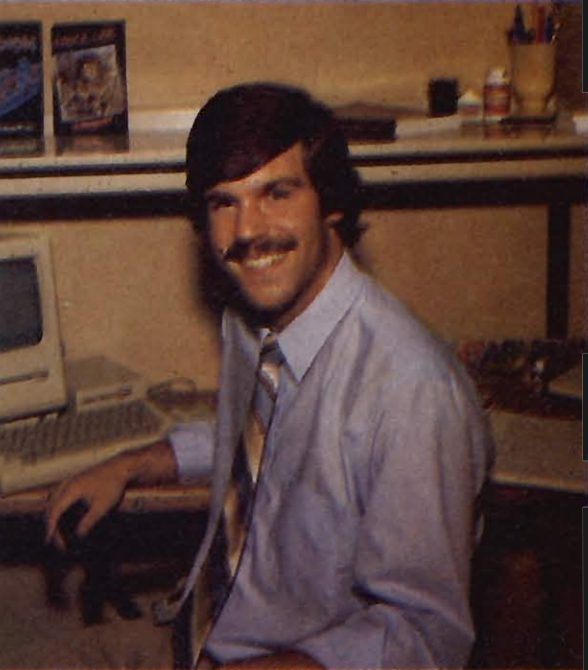 Ron J. Fortier, ca. 1984
Ron J. Fortier, ca. 1984
It turned out that the next licence secured by DataSoft would be a game starring the legendary martial artist, actor and 1958 Hong Kong Cha-Cha champion - Bruce Lee.
The deal was put together with the Bruce Lee estate and Ziv International by CEO Pat Ketchum and Director of Business Development, Steve Bloom.
The team now had to find a direction they wanted to take the game.
‘Let's face it,’ admitted Fortier at the time, ‘The whole Bruce Lee phenomenon was pretty much dead at the time - no morbid pun intended,’ he quickly added.
Perhaps with the benefit of hindsight, in a much later interview with Retro Gamer Magazine in 2015, Fortier remembers, ‘It was later that the core essence of what I was creating became the game known as Bruce Lee. We knew it would be big. There were great licences that you could dig your teeth into, and none were better than Bruce Lee. It obviously had name recognition, but it also set an expectation for the gameplay.’
The team watched all the Bruce Lee movies, as well as other martial arts films on videotape to seek inspiration and true enlightenment.
Mitch Junkins, Director of Marketing at DataSoft at the time, added that in order to create the proper spiritual deportment for creating such a game, the team also ‘ate a lot of sushi.’
Fortier: ‘The three core game mechanics were fairly obvious: platform exploration, timing and fighting. We had this idea of utilizing really fantastic graphics to create a sort of computer-movie with the player as character. We wanted the animation in particular to be outstanding.’
Kelly Day, graphics artist and co-designer, read extensively on Asian architecture and attempted to integrate the visual effects he saw in the films.
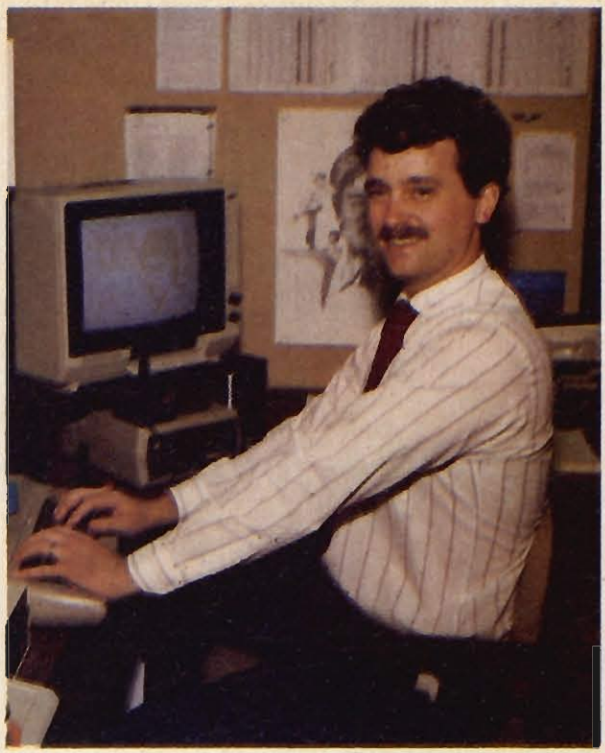 Kelly Day, ca. 1984
Kelly Day, ca. 1984
Fortier adds, ‘We had just started to use graphics editors at DataSoft around the time we started Bruce Lee. Prior to that point, programmers did graphics by hand. Kelly was a master artist that understood the limitations of the systems and how to exploit them for visuals.’
Guarding the Wizard's fortress is the large, green sumo-wrestler Yamo and his sidekick, the nameless black Ninja. Yamo can punch and throw devastating flying kicks, while the Ninja delivers blows using his ‘Bokken stick.’
However, Bruce can often outmaneuver them by a timely duck that sometimes even causes them to fight eachother!
Fortier: ‘A two-player game was impossible, but playing one of the non-player characters and foiling your friend was not. It was easy to hook up the non-player characters to the joysticks.’
The game indeed sports a multiplayer option, either by taking turns as Bruce - with separate scoring, or having a friend control the Green Yamo. Ah yes, the memories of Being Yamo, standing on a ledge biding his time waiting for Bruce to come around, then swiftly delivering a well-timed punch that tumbled him to his death was immensely satisfying.
Kelly Day recalls, ‘Some of the best things in this game just... happened! We had gotten all of Bruce Lee's moves down and Ron was just sort of playing around, using a joystick to control the Green Yamo...’
A fun two-player strategy was for Bruce and Yamo teaming up on the weaker Ninja, thus helping the hero to more easily complete his adventure. A sneaky way for single players to circumvent the anti-cheating mechanism was to start a two player game and weighing down the fire button on the second joystick. Yamo would just stand there endlessly punching without posing much of a threat.
The fortress which Bruce must traverse consists of 20 chambers. It's riddled with deadly traps and hazards such as spikes, electrical charges, switching platforms, rolling vines, floor lights, and exploding ‘T'sung-lin’ bushes.
Fortier: ‘Every designer wants a varying level of difficulty in their games. You don't want someone to run through it, and you don't want to frustrate someone. The key for Bruce Lee was to get it dialled in at the right rates. I, luckily, had a development system that allowed me to assemble my code and test rapidly.’
One of the primary factors for it's longevity, in my opinion, is that the difficulty level is relaxed a bit compared to contemporary games. Even though there are some accurate timing and reflexes required, the game never feels too hard to master, even for novice players.
Fortier, on the other hand, had one regret about the difficulty level: ‘Pat Garcia was president and he had problems playing the game, so he had me dial it back a bit. Given the choice I would have gone with the second to last settings as I felt they were perfect.’
The game was assembled on an Apple II, then beamed into a slave Atari for testing. This allowed for quick turnaround from code to test.
Mitch Junkins remembers, ‘We had weekly updates with Ron and the other programmers to look at the gameplay and discuss completion.’—‘I always had to bribe them with donuts to get them to come to the meetings,’ he laughs.
Finishing up the game took eight months, and the game was released for the US Atari market in June of 1984, retailing at $34.95 for the disk version. A C64 port quickly followed, in time for the coming Christmas season.
Fortier recalls, ‘The first conversion was to the C64. As I had increased RAM and 25 per cent more CPU speed, I decided to write an Atari emulator. Apple, PC and PCjr were in-house, so I was able to work with the programmers.’
(Aside note: For a while I was wondering what he meant by ‘Atari emulator’. It finally dawned on me while chatting with the cool guys doing the Atari port of Return of Fury, where I mentioned that the tile collision detection in the C64 version used tile-mask data, and they replied ‘What mask data?’ - Ah, my dear Mr. Hastings; the Atari hardware-based player-object to background collision detection was indeed emulated on the C64, cutting down on development time!)
External developers converted the game to other platforms — Amstrad CPC, BBC Micro, FM-7, MSX, NEC PC-88, Sharp MZ-800 and the ZX Spectrum.
Fortier: ‘You really couldn't say much about the Spectrum as I just remember it blinking a lot. The MSX was fun, but working internationally was challenging at the time so our team couldn't help that much on quality.’
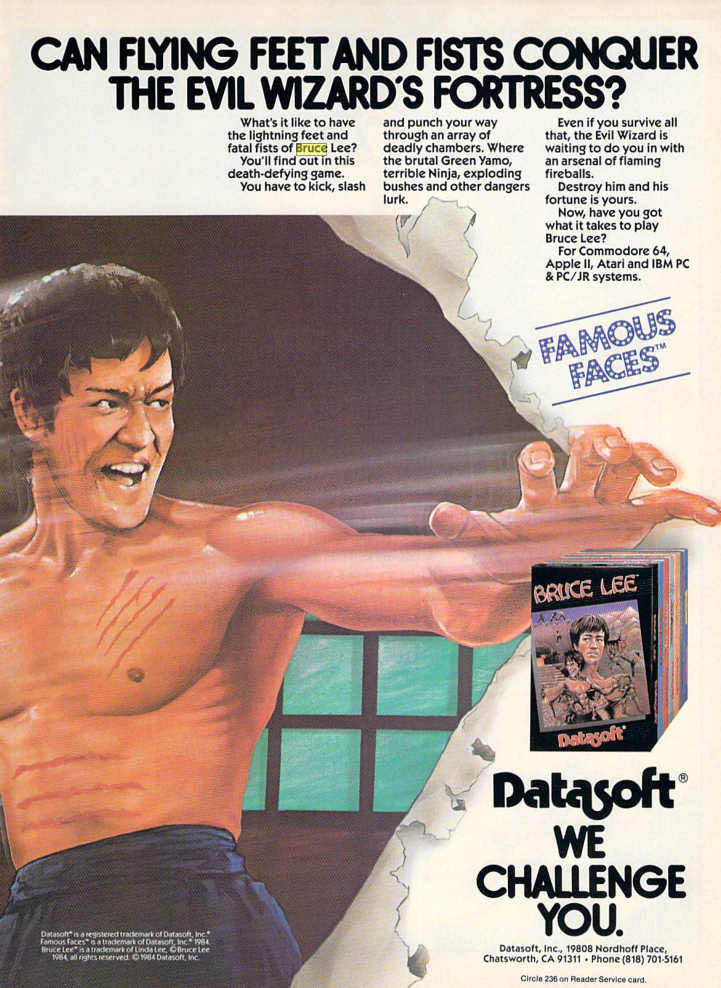 Ad, Run Magazine Dec. 1984
Ad, Run Magazine Dec. 1984
Bruce Lee was generally well received, with scepticism about yet another celebrity game tie-in put to shame.
Somehow a copy (or at least, a press release) ended up in the hands of Steve Marano, author of the Micro of Monmouth Atari enthusiast's newsletter, as early as April of 1984.
[...] In summary, the combination of excellent graphics and playability as provided by Ron Fortier with a thoughtful packaging policy as practiced by DataSoft results in a thoroughly enjoyable game. I wholeheartedly recommend BRUCE LEE. (p. 4)
Of the bigger publications, David P. Stone reviewed the game in the June 1984 issue of Computer Gaming World:
I don't know what ‘martial arts’ is, but I know what I like. And, I like Bruce Lee. It delivers all the foot kicking, fist jabbing, quick ducking action-packed adventure you'd expected from a good grade B, martial arts movie. (p. 32)
Fortier: ‘I was blown away by it's success. While it pales in comparison to today's dollars, I think we had a higher percentage of the installed base. It was one of those games that everyone had.’
Some speculation about a sequel would surface when, [then] DataSoft president Sam Poole revealed in an interview about Alternate Reality:
Obviously as we're designing and developing the [Alternate Reality] series, we've learned a great deal about random character generation, and logic and statistics. As a result, we're now looking to use some of those same types of features in a follow up program based on Bruce Lee, which has been a major seller in Europe.
Called Bruce Lee - Enter the Dragon, it will be a full roleplaying adventure and have strong hi-res graphics and animation sequences, but taking advantages of some of the techniques we've developed in [Alternate Reality]. Combining the best of both. (Zzap! 64, May 1986, p. 76)
In 2022, Fortier responded on social media to the fact that there never was an official sequel:
That is correct. I and others did want to start on a sequel immediately after finishing the original, but management at DataSoft wouldn't green-light the project / cash. (8th July 2022)
Mitch Junkins on the sequel: ‘I don't know how it [Bruce Lee, ed.] performed against our royalty guarantees, but that usually drives the business decision. I believe the license was one and done.’
Ron's next project would be the Atari and C64 versions of another licence, Conan - The Halls of Volta (1985), followed by his final 8-bit project, the C64 conversion of Alternate Reality: The City (1986), but he decided to move on to Epyx as a project manager before it was finished.
DataSoft could not secure further funding and had to file for bankruptcy in 1987.
The game continues to inspire hobby game developers around the world — including myself — to create new games set in the Bruce Lee universe.
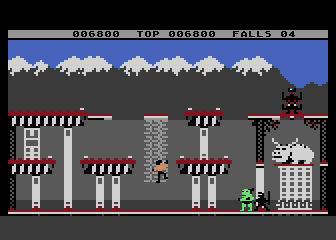 |
Atari 800 XL | Ron J. Fortier, Kelly Day | 1984 US Gold (Aug) | Video |
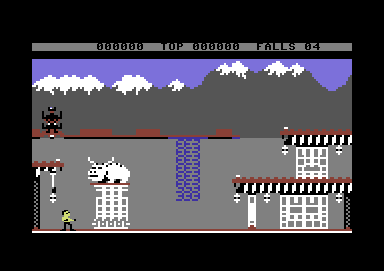 |
Commodore 64 | Ron J. Fortier, Kelly Day, John A. Fitzpatrick | 1984 US Gold (Sep) | Video |
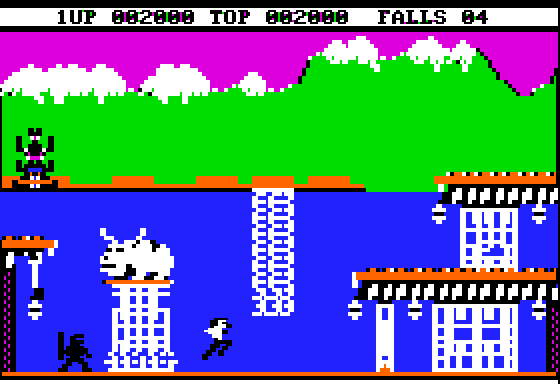 |
Apple II | Rick Mirsky | 1984 DataSoft Inc. | Video |
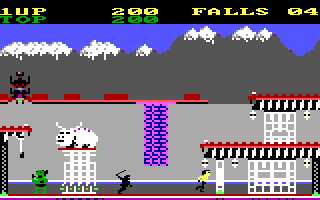 |
PC / PCjr. | Sheng-Chung Liu | 1984 DataSoft Inc. |
PCjr Video DOS Video |
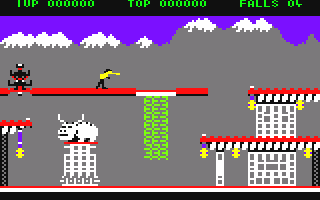 |
Amstrad CPC | Timedata Ltd. | 1984 US Gold |
Video |
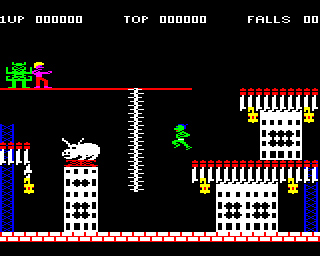 |
BBC Micro | D. Cowham | 1984 Micro Power Ltd. |
Video |
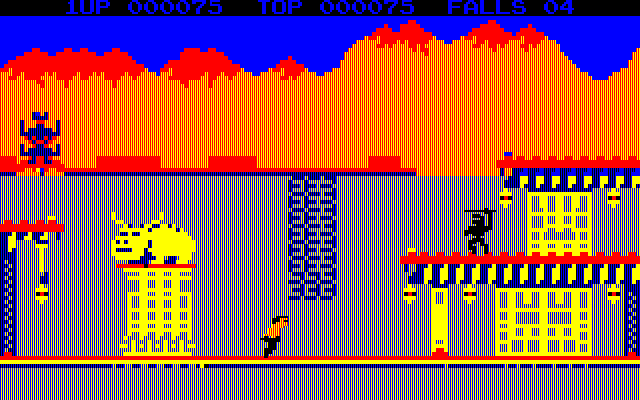 |
FM-7 | Mitani Matsuda | 1984 Comptiq (Sep) |
Video |
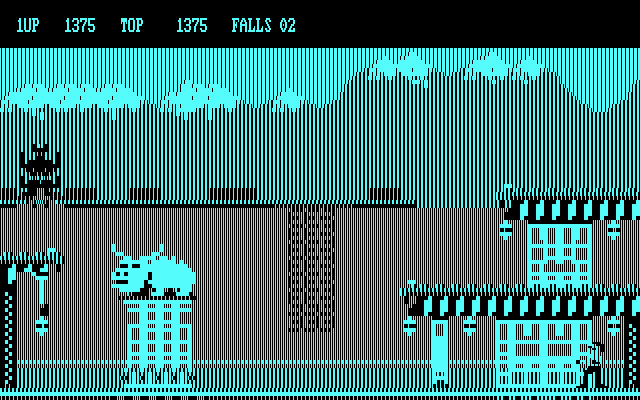 |
NEC PC-88 | 1984 Comptiq (Oct) |
Video |
|
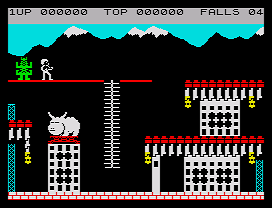 |
ZX Spectrum | L.T. Software | 1985 Ocean |
Video |
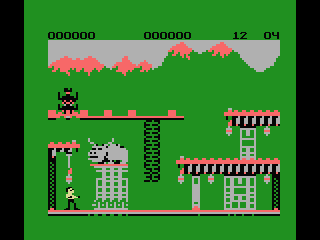 |
MSX | Mike Livesay | 1985 Comptiq |
Video |
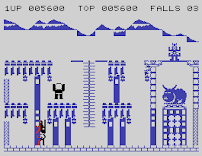 |
Sharp MZ-800 | J.O. | 1988 Vsetin (Apr) |
Video |
| April 1984 | Micro of Monmouth | US | Atari | Recommended | View on archive.org |
| April 1984 | Atari Computer Enthusiasts | US | Atari | Favourable | View on archive.org |
| April 1984 | Computer Entertainer | US | Atari | Favourable | View on archive.org |
| June 1984 | Analog Computing | US | Atari | Favourable | View on archive.org |
| June 1984 | Computer Gaming World | US | Atari |
Getting started: 7
Graphics: 9
Value: 7
Playability: 7
|
View on archive.org |
| July 1984 | K-Power | US | Atari |
Graphics: 4/5
Excitement: 4/5
Originality: 5/5
Ease of use: 5/5
Challenge: 4/5
Shelf life: 3/5
|
View on archive.org |
| August 1984 | Computer & Video Games | UK | Atari |
Getting started: 7
Graphics: 9
Value: 7
Playability: 9
|
View on archive.org |
| September 1984 | Joystick | Sweden | Atari |
Value: 4/5
Graphics: 4/5
|
View on archive.org |
| November 1984 | TV Gamer | US | Atari |
Value: 4.5
Graphics: 4.5
Sound: 3
Gameplay: 4.5
|
View on archive.org |
| December 1984 | Personal Computer Games | UK | (C64) |
Graphics: 8
Sound: 5
Originality: 8
Lasting interest: 8
Overall: 8
|
View on archive.org |
| January 1985 | Commodore Horizons | UK | C64 |
Graphics: 6 stars
Sonics: 6 stars
Gameplay: 6 stars
|
View on archive.org |
| January 1985 | Commodore User | UK | C64 |
Presentation: 5/5
Skill level: 3/5
Interest: 3/5
Value for money: 4/5
|
View on archive.org |
| January 1985 | HC Home Computer | Italy | Atari | TBD | View on archive.org |
| January 1985 | Home Computing Weekly | UK | C64 |
Instructions: 85%
Graphics: 90%
Playability: 90%
Value for money: 80%
|
View on archive.org |
| February 1985 | Big K | UK | C64 |
Graphics: 3 K's
Playability: 3 K's
Addictiveness: 3 K's
|
View on archive.org |
| April 1985 | L'Atarien | France | Atari | TBD | View on archive.org |
| March 1985 | Page 6 | UK | Atari | Favourable | View on archive.org |
| March 1985 | Your 64 | UK | C64 | 3 of 5 stars | View on archive.org |
| May 1985 | A Tutto Commodore | Italy | C64 | Not scored | View on archive.org |
| May 1985 | Computer & Video Games | UK | Spectrum |
Graphics: 9
Sound: 8
Value: 9
Playability: 9
|
View on archive.org |
| May 1985 | Crash Magazine | UK | Spectrum |
Use of computer: 85%
Graphics: 90%
Playability: 89%
Getting started: 80%
Addictive qualities: 92%
Value for money: 85%
Overall: 91%
|
View on archive.org |
| May 1985 | Sinclair User | UK | Spectrum | 4 of 5 stars | View on archive.org |
| May 1985 | Your Spectrum | UK | Spectrum |
Dave: 3½/5
Ross: 2/5
Roger: 2/5
|
View on archive.org |
| July 1985 | Commodore Magazine | Italy | C64 | Recommended | View |
| January 1986 | Amstrad Computer User | UK | Amstrad |
Graphics: 17
Sound: 14
Polish: 15
First impression: 16
Lasting impression: 18
Value: 18
|
View on archive.org |
| January 1986 | Amtix | UK | Amstrad |
Presentation: 83%
Graphics: 88%
Sound: 79%
Playability: 94%
Addictive Qualities: 95%
Value for Money: 89%
Overall: 93%
|
View on archive.org |
| March 1986 | Amstrad Computer User | UK | Amstrad |
Graphics: 17
Sound: 14
Polish: 15
First impression: 16
Lasting impression: 18
Value: 18
|
View on archive.org |
| March 1986 | CPC Schneider International | Germany | Amstrad |
Idea: 4/10
Playability: 7/10
Documentation: 6/10
Graphics: 9/10
Sound: 7/10
Price: 10/10
|
View on archive.org |
| August 1988 | Zzap! 64 | UK | C64 |
Presentation: 83#
Graphics: 54%
Sound: 49%
Hookability: 91%
Lastability: 95%
Overall: 92%
|
View on archive.org |
| March 1989 | MSX Club | Spain | MSX |
First minute: 7/10
First hour: 6/10
First day: 6/10
After a week: 5/10
After a month: 5/10
After a year: 5/10
|
View on archive.org |
| December 1990 | Your Commodore | UK | C64 |
Graphics: 40
Sound: 60
Brains: 60
Overall: 75
|
View on archive.org |
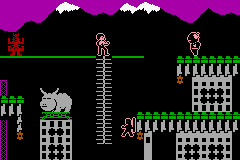 |
Gameboy Advance | Jim Bagley | 2003 Jim Bagley | Website |
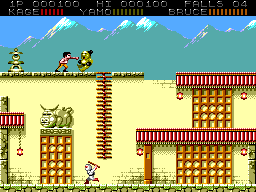 |
Sega Master System | Kagesan | 2015 Kagesan | Video |
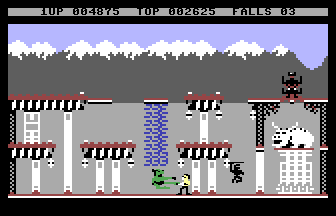 |
Commodore Plus4 | Sasvári, Tamás (TCFS), Tettinger, Tamás (Chronos), Pankaczy, Csaba (Csabo) | 2022 Psytronik |
Video Plus4World |
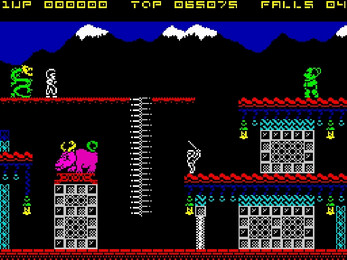 |
ZX Spectrum | Highriser | 2022 Highriser | Itch |
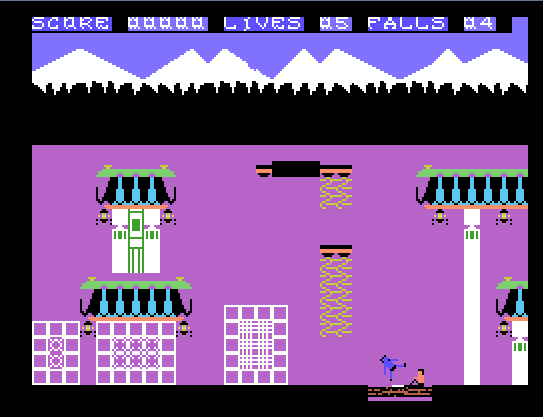 |
Karate King | Memotech MTX500 | Mike Bayne, Chris Bayne | 1985 Megastar Games Inc. | Video |
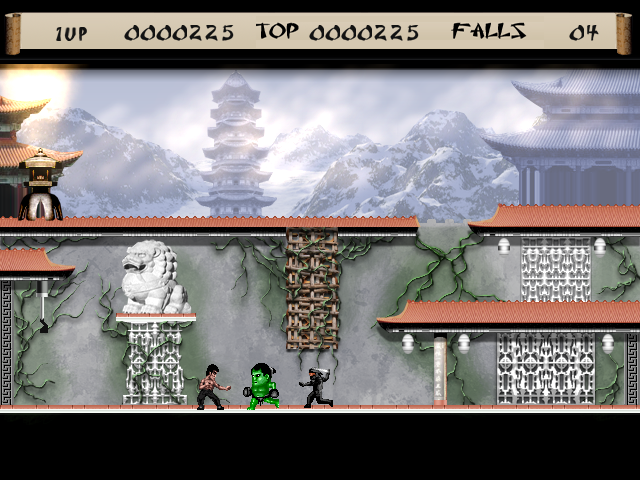
|
Ultimate Bruce Lee | Windows | Stu Collier, Smila Storey, Infamous | 2005 Stu and Smila | Video |
 |
Bruce Lee II | Windows | Bruno R. Marcos | 2013 Bruneras.com | |
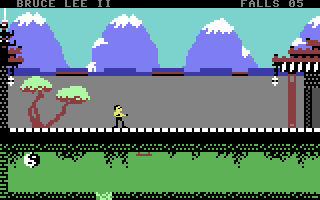 |
Bruce Lee II | Commodore 64 | Jonas Hultén | 2015 Kollektivet.nu | |
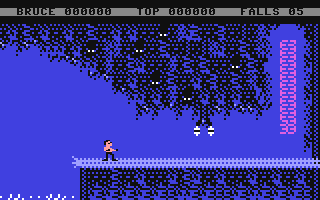
|
Return of Fury | Commodore 64 | Vidar Bang (dmx), FlowTnt, TIX | 2019 Rebel Android | |
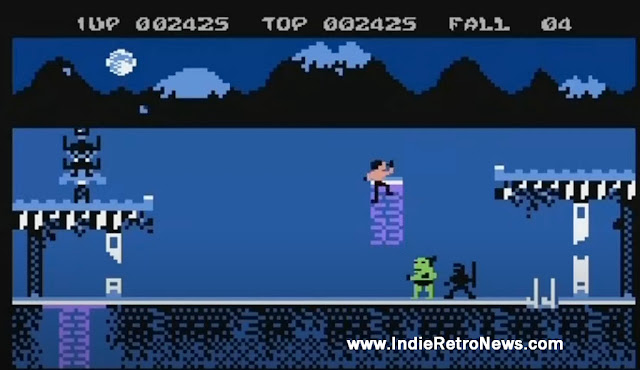
|
Return of Fury | Atari XL/XE | Ute, Fantomas, TIX | 2022 | Video |
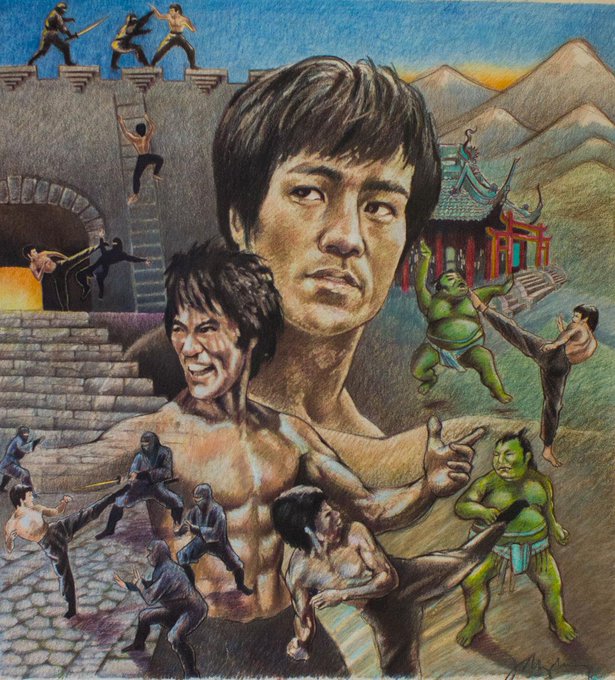
Artist: Unknown - if you know who made this, let me know.
The font for the ‘Bruce Lee’ lettering used in the box and manual was sourced from Speedball textbook for pen & brush lettering, 18th edition (1960), specifically Far East Type (p. 40)
It has been reworked into digital as China Doll JNL by Jeff Levine.